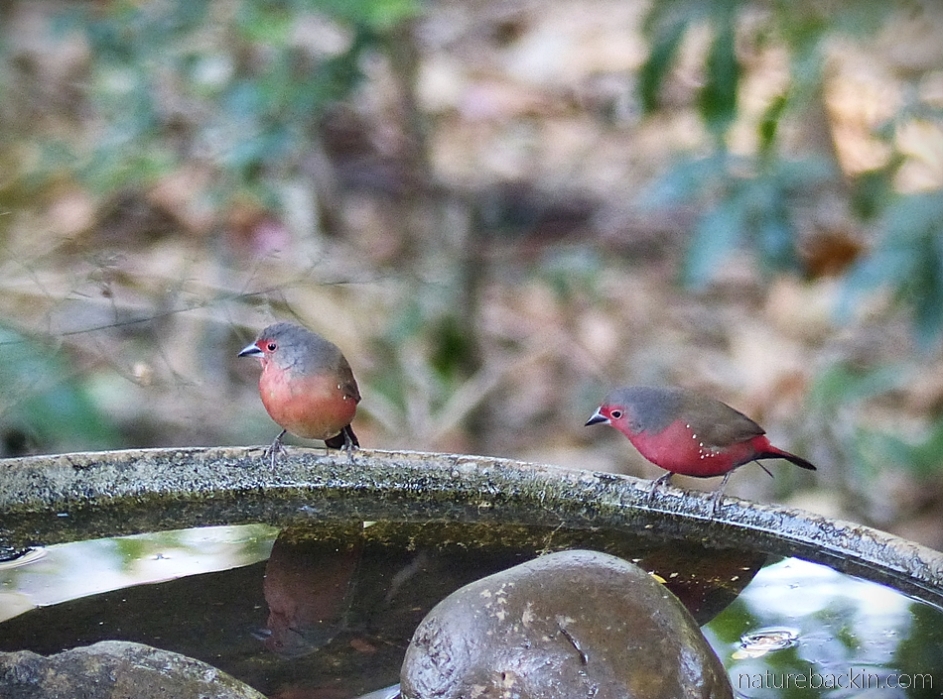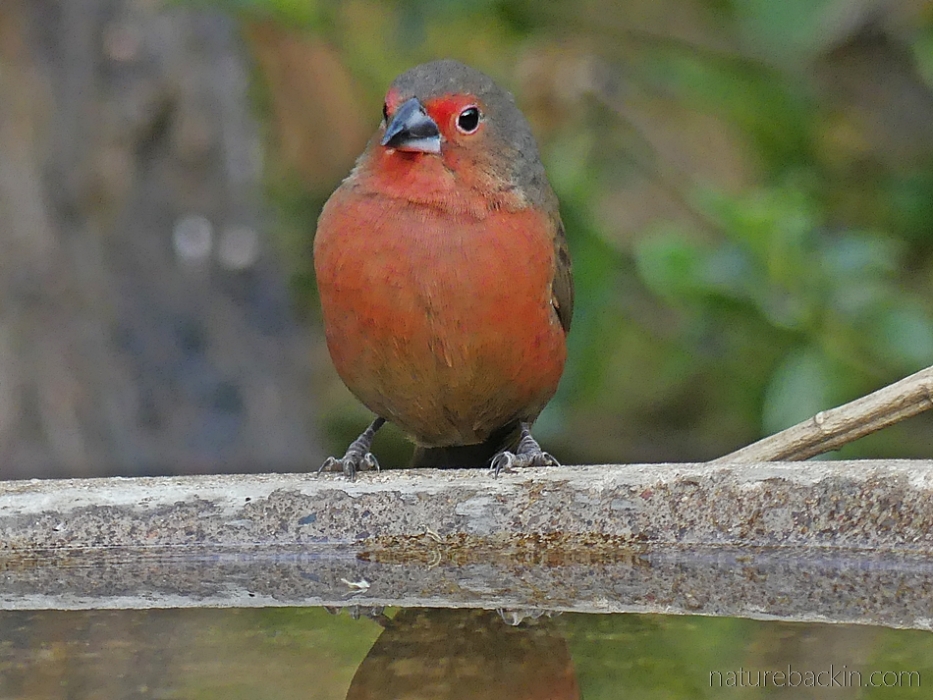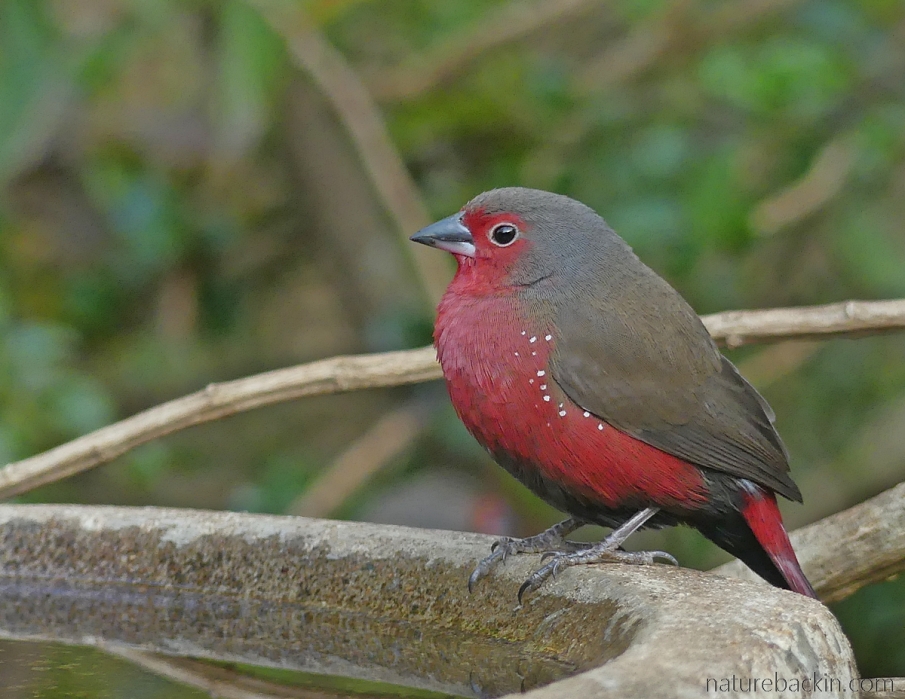I hear the tinkling call of visiting African firefinches more often than I see them. They forage on the ground and in low vegetation, venturing out into open ground when undisturbed.
In our garden, we see African firefinches visiting in pairs. Their striking red colouration and the decorative white spots on the flanks, which are more pronounced and numerous in the male, are always a delight to see.

A male African firefinch, with white spots clearly visible, approaching one of the garden birdbaths
There are a total of 11 species of firefinches all of which occur in Africa. The genus name Lagonosticta derives from the Greek words lagōn meaning ‘flank’ and stiktos meaning ‘spotted’. Of these 11 species, only 4 are found in the southern African region with one of these, the brown firefinch, occurring in northern Botswana. The three firefinches that occur in South Africa are found mostly in areas in the eastern part of the country – they are the African firefinch, Jameson’s firefinch and the red-billed firefinch.
The African firefinch, Lagonosticta rubricata (rubricata means red), occurs as far north in Africa as Senegal in the west and Eritrea in the east and is found in many African countries south of the Sahara. It is not found in arid regions as it favours moister and well vegetated habitats including forest margins and thickets, and it is often found near rivers and streams and seen in gardens and rural villages.
Click on this link to the xeno-canto website to see a distribution map and to hear recordings of the tinkling and trilling calls of the African firefinch.

An African firefinch looking for food on an open patch of ground in our garden
Like other firefinches, the African firefinch forages mostly on the ground for seeds and insects. The African firefinch is known to peck energetically with closed bill to break up hard ground when looking for food.
Its alternative English name is bluebilled firefinch on account of its slate-blue coloured bill (although the Jameson’s firefinch also has a blue-black bill).

An African firefinch in our garden with a caterpillar, proving that they don’t only eat seeds
African firefinches are monogamous solitary nesters. The male builds the ball-shaped nest with a side entrance. Most nests are in dense vegetation and are about 0.5 to 2 meters (1.5 to 6.5 feet) from the ground. Once the nest is built, both sexes maintain the soft lining of nest, which is made up from grass inflorescences and feathers.

A pair of African firefinches at one of the garden birdbaths. The female on the left is paler or pinker in colour than the male. Typically the female has fewer white spots than the male
When breeding the female lays 3–5 eggs in a clutch. The eggs are incubated by both adults during the day and by the female at night. Nestlings are fed in the nest for about the first two weeks by both parents who regurgitate food for the chicks. After leaving the nest the youngsters continue to be fed by both parents for about ten days while they learn to forage for themselves.
The African firefinch is the only known host species of the dusky indigobird (also known as the black widowfinch), which is a brood parasite. Although they occur in this region, I have not noticed any dusky indigobirds in our garden.

A female African firefinch about to drink at a birdbath in the garden
Sadly, firefinches are utilised in the international captive bird trade. Mortality rates in the wild bird trade are notoriously high at all stages in the process – at the pre-export stage, during transportation, and after importation into the country of destination. Being African, firefinches are adapted to warm climates and have high mortality rates in destination countries with a colder climate. For general information on the welfare of both wild-caught and captive-bred caged birds see this article from PETA.

A male African firefinch at a birdbath in the garden
Firefinches are tiny birds. They are approximately 11–12 cm (3–4.5 inches) in length and weigh about 10 g (0.35 ounces). In comparison a house sparrow on average is larger, being 14-15 cm (5.5–6 inches) in length and weighing over twice as much as an African firefinch, being 25-26 g (0.8–0.9 ounces) in weight.
Despite their tiny size, the tinkling call of the African firefinches and their busy foraging when they come out into the open make them a dynamic presence in the garden.
Sources: Chittenden, Hugh, Davies, Greg & Weiersbye, Ingrid. 2016. Roberts Bird Guide: Illustrating nearly 1,000 Species in Southern Africa (2nd edition). Cape Town: Jacana; PETA. [n.d.] Captured or Captive Bred Birds. https://www.peta.org/issues/animal-companion-issues/animal-companion-factsheets/captured-captive-bred-birds/; Roberts VII Multimedia PC Edition. 1997-2016 Southern African Birding. For details go to http://www.sabirding.co.za/roberts7/portal.html
Posted by Carol









September 19, 2020 at 4:44 am
What utterly delightful and beautiful birds. I’ve never seen any that have that unusual red. The white spots add to the effect. That first recording sounds almost like a cricket. What a delightful post about a bird I never knew existed.
LikeLiked by 1 person
September 20, 2020 at 7:38 pm
They are gorgeous little birds, and the white spots do set off the red beautifully.
LikeLike
August 30, 2020 at 1:39 pm
Interesting little bird. Looks somewhat like a cross between our European robin and a chaffinch, although obviously not related to either.
The wild bird trade is still a major problem in so many countries. Hopefully one day it will be brought under proper control.
LikeLiked by 1 person
August 30, 2020 at 8:06 pm
Thanks Adele.
Hopefully yes the wild bird trade will be better regulated. (It would be even better if attitudes changed and caged birds were no longer considered desirable.)
LikeLike
August 30, 2020 at 9:50 am
Your photos of the little firefinches really do them justice. Stunning photos indeed! I have seen those birds before (although my memory fails me as to where I saw them). I certainly did not get any good photos of them! I had no idea that they could host the black widowfinch! I am very much against captive birds! How sad that they are captured to be sold. Thank you for a lovely post!
LikeLiked by 1 person
August 30, 2020 at 7:58 pm
Thanks very much. I didn’t know about them hosting the black widowfinch either until I read for this post. I gather that the African firefinch is the only host species of the black widowfinch (dusky indigobird).
I feel the same about captive birds, and the high mortality rate in the international trade in wild birds makes it even worse.
LikeLiked by 1 person
August 28, 2020 at 12:05 pm
They certainly are delightful birds. I was distressed to read about their being exported for trade…
LikeLiked by 1 person
August 28, 2020 at 5:00 pm
Yes they are truly delightful.
The caged bird trade is very distressing. Hard to understand why people think creatures that were born to fly and that form social relationships be they in pairs, the family or in wider groups, can be happy in cages, often in solitary confinement.
LikeLike
August 28, 2020 at 5:08 pm
☹️
LikeLiked by 1 person
August 28, 2020 at 7:18 am
What a delightful little bird. I hope rather a lot are making their homes in your garden, safe from any predators!
LikeLiked by 1 person
August 28, 2020 at 4:57 pm
It really is delightful. I am not sure how many pairs visit as we only see one pair at a time, and I also don’t know where they make their nest. There is a lot about our visitors that we are completely ignorant of!
LikeLiked by 1 person
August 30, 2020 at 2:43 pm
That surprises me. They’re very good at hiding then.
LikeLiked by 1 person
August 30, 2020 at 8:09 pm
They visit our garden for foraging but I expect that they nest outside our garden, such as in a less disturbed strip of dense vegetation along the margins of the adjacent commercial plantation.
LikeLiked by 1 person
August 28, 2020 at 7:13 am
So sweet Carol. You are so fortunate to have these tiny little birds visit your garden.
LikeLiked by 1 person
August 28, 2020 at 4:54 pm
Yes they are incredibly sweet, and we are very fortunate to have them as visitors.
LikeLike
August 28, 2020 at 4:00 am
What a pretty bird and such a distinctive call. I had my volume up rather high and nearly blew an eardrum!
LikeLiked by 1 person
August 28, 2020 at 4:52 pm
Ooh sorry about the eardrum! It might be a tinkling call but it is a rather penetrating tinkle …
LikeLiked by 1 person
August 29, 2020 at 2:37 am
The fault was more mine than the bird’s.
LikeLike
August 28, 2020 at 3:36 am
Absolutely delightful Carol! I love all the finches, small jewels! xxx
LikeLiked by 1 person
August 28, 2020 at 4:28 pm
That is such an apt description Christeen – they really are like small jewels xxx
LikeLiked by 1 person
August 28, 2020 at 2:59 am
I agree with you that they are a delight to behold, Carol. On seeing any of “our” firefinches my mood always lifts and I don’t think I’ve ever watched them without a smile on my face.
As always, your images are absolutely stunning. If you are on facebook, perhaps you could consider joining this little group: https://www.facebook.com/groups/1914635922177485/
LikeLiked by 1 person
August 28, 2020 at 4:26 pm
The firefinches do have a particular charm.
Thanks for alerting me to the group – it looks very interesting and I consider it a compliment that you ask me to consider joining. Up until now I have resisted joining FB, but perhaps one day that might change 🙂
LikeLiked by 1 person
August 27, 2020 at 9:16 pm
Awww, they’re so fluffy! 🙂 Great pics
LikeLiked by 1 person
August 28, 2020 at 4:22 pm
Thanks M.B. They are very cute little birds 🙂
LikeLiked by 1 person
August 27, 2020 at 8:32 pm
What a stunning little bird!
LikeLiked by 1 person
August 28, 2020 at 4:21 pm
It is indeed – thanks Sandy.
LikeLiked by 1 person
August 28, 2020 at 4:26 pm
Welcome, Carol.
LikeLike
August 27, 2020 at 7:22 pm
WHAT a delight to see your fantastic photographs! I have recorded both firefinches and indigo birds in our garden, but that was several years ago. A pair of firefinches visited our garden for two days in a row last year, which thrilled me no end. Enjoy these lovely looking birds in your garden.
LikeLiked by 1 person
August 28, 2020 at 4:11 pm
Thanks Anne. I have seen indigo birds is the farmlands but not in our suburb. Perhaps you may get more firefinches visiting this season. We certainly do enjoy the firefinches that visit us here.
LikeLike
August 27, 2020 at 7:18 pm
Such a pretty little bird! I liked listening to their trilling call, too. Thanks for the intro, Carol.
LikeLiked by 1 person
August 28, 2020 at 4:10 pm
Thanks Eliza – glad you listened to the audio – their sound is as striking as their appearance.
LikeLiked by 1 person